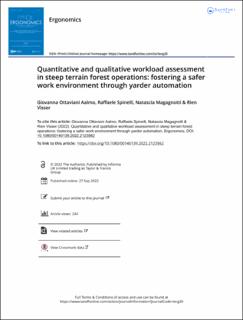| dc.contributor.author | Ottaviani Aalmo, Giovanna | |
| dc.contributor.author | Spinelli, Raffaele | |
| dc.contributor.author | Magagnotti, Natascia | |
| dc.contributor.author | Visser, Rien | |
| dc.date.accessioned | 2022-11-07T10:20:28Z | |
| dc.date.available | 2022-11-07T10:20:28Z | |
| dc.date.created | 2022-10-25T16:36:56Z | |
| dc.date.issued | 2022-09-27 | |
| dc.identifier.citation | Ergonomics. 2022, 1-13. | en_US |
| dc.identifier.issn | 0014-0139 | |
| dc.identifier.uri | https://hdl.handle.net/11250/3030360 | |
| dc.description.abstract | Many forestry roles have changed from being manual tasks with a high physical workload to being a machine operator task with a high mental workload. Automation can support a decrease in mental fatigue by removing tasks that are repetitive and monotonous for the operators. Cable yarding presents an ideal opportunity for early adoption of automation technology; specifically the carriage movement along a defined corridor. A Valentini V-850 cable yarder was used in an Italian harvesting setting, in order to gauge the ergonomic benefit of carriage control automation. The study showed that automating yarder carriage movements improved the ergonomic situation of the workers directly involved in the related primary tasks. However, the caveat is that improving one work task may negatively affect the other work tasks, and therefore introducing automation to a worksite must be done after considering all impacts on the whole system. Practitioner summary: Automation decreased the winch operator’s mental workload while improving overall productivity. At the same time, the mental and physiological workload of the operator tasked with bucking were slightly increased. Ideally, winch automation should be coupled with bucking mechanisation to balance the intervention and boost both operator well-being and productivity. | en_US |
| dc.language.iso | eng | en_US |
| dc.publisher | Informa UK Limited, trading as Taylor & Francis Group | en_US |
| dc.rights | Attribution-NonCommercial-NoDerivatives 4.0 Internasjonal | * |
| dc.rights.uri | http://creativecommons.org/licenses/by-nc-nd/4.0/deed.no | * |
| dc.title | Quantitative and qualitative workload assessment in steep terrain forest operations: fostering a safer work environment through yarder automation | en_US |
| dc.title.alternative | Quantitative and qualitative workload assessment in steep terrain forest operations: fostering a safer work environment through yarder automation | en_US |
| dc.type | Peer reviewed | en_US |
| dc.type | Journal article | en_US |
| dc.description.version | publishedVersion | en_US |
| dc.rights.holder | © 2022 The Author(s) | en_US |
| dc.source.pagenumber | 1-13 | en_US |
| dc.source.journal | Ergonomics | en_US |
| dc.identifier.doi | 10.1080/00140139.2022.2123562 | |
| dc.identifier.cristin | 2064957 | |
| cristin.ispublished | true | |
| cristin.fulltext | original | |
| cristin.qualitycode | 1 | |

